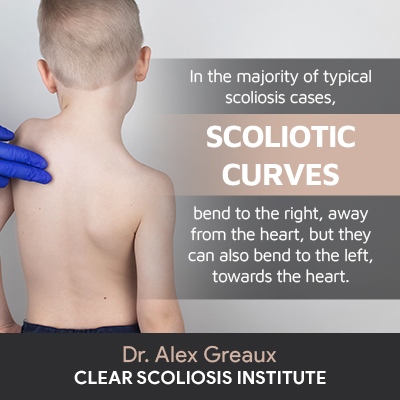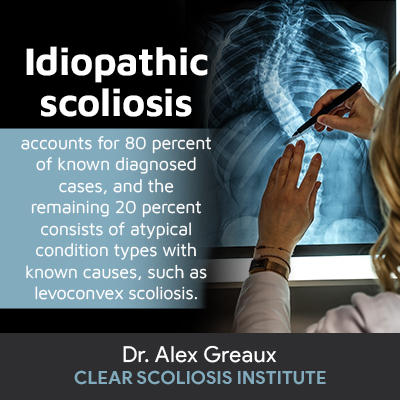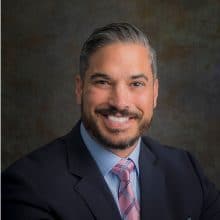
When scoliosis is diagnosed, it’s further classified based on a number of important patient and condition characteristics. While most scoliotic curves bend to the right, away from the heart, they can also bend to the left, towards the heart; this is classified as levoscoliosis and can have a number of causes.
Levoscoliosis refers to abnormal spinal curvatures that bend to the left, towards the heart. Levoconvex scoliosis is a further specification that indicates it’s the curve’s outer edge that bends to the left. Levoconvex scoliosis is atypical and likely to have an underlying pathology.
Before exploring the specifics of levoconvex scoliosis, let’s break down what the term levoconvex scoliosis means.
The spine is naturally curved because it makes it stronger, more flexible, and better able to distribute mechanical stress that’s incurred during movement.
There are a number of spinal conditions a person can develop that involve a loss of the spine’s healthy and natural curves, and with close to seven million people currently living with scoliosis in the United States alone, scoliosis is one of the most prevalent.
In order for a scoliosis diagnosis to be given, certain parameters have to be met. When someone is diagnosed with scoliosis, this means they have an abnormal sideways spinal curvature, with rotation, and a minimum Cobb angle of 10 degrees.
It’s important to understand scoliosis as a 3-dimensional condition because of its rotational component. Not only does a scoliotic spine bend from side to side, it also twists from front to back, back to front; in order for scoliosis treatment to be effective, it has to treat the whole spine by addressing the condition’s 3-dimensional nature.
Cobb angle is a measurement obtained via X-ray that tells me how far out of alignment a scoliotic spine is and determines condition severity.
When a condition is diagnosed, it’s further classified based on important patient and condition characteristics such as condition severity and curvature type, meaning location and pattern.
If a diagnosis of levoconvex scoliosis has been given, this provides specifics about the type of spinal curvature and the direction in which it bends. Levo means left, and dextro means right.

In the majority of typical scoliosis cases, scoliotic curves bend to the right, away from the heart, but they can also bend to the left, towards the heart.
Levoscoliosis are cases of scoliosis where the spinal curvature bends to the left, instead of the right, and levoconvex scoliosis is a further specification of levoscoliosis that it’s the curvature’s convex side (outer edge) that bends to the left.
Scoliosis can develop in any of the spine’s three main sections: cervical (neck), thoracic (upper/middle back), and lumbar (lower back).
Also referred to as thoracic levoscoliosis, levoconvex scoliosis most commonly affects the thoracic spine, but it can also develop along the lumbar spine.
So what does levoscoliosis mean? It means the presence of an abnormal spinal curve that bends to the left and is an atypical form that’s likely to have unique treatment needs.
While every case is different and produces its own unique set of symptoms, levoscoliosis symptoms can include postural changes that affect the body’s overall symmetry such as uneven shoulders, shoulder blades, uneven hips, the presence of a rib arch, an uneven waistline, and depending on condition severity, an abnormal spinal curve that’s visible to the naked eye.
In addition, changes to gait, balance, and coordination can also develop, as well as ill-fitting clothing.
While pain can be a common symptom of levoscoliosis in adults, it’s less likely to be a symptom in younger patients as they have not yet reached skeletal maturity; the constant lengthening motion experienced by a growing spine can counteract the compressive force of the curvature.
Another important condition characteristic that’s part of the classification process is condition type, and this is largely determined by causation.
Scoliosis is a highly-variable condition, not just in terms of severity, but also in the different condition types that can develop.
As mentioned, when a scoliosis diagnosis is given, it’s further classified based on important variables such as patient age, condition severity, curvature location/pattern, and condition type (cause).
While we have gained in our understanding of scoliosis over the years, there is still a lot about the condition we don’t fully understand, mainly in terms of causation.
In fact, the most prevalent type of scoliosis is idiopathic, meaning not associated with a single-known cause. This is not the same as saying there is a complete absence of cause as idiopathic scoliosis is, instead, considered to be multifactorial: caused by multiple variables that can vary from one patient to the next.

Idiopathic scoliosis accounts for 80 percent of known diagnosed cases, and the remaining 20 percent consists of atypical condition types with known causes, which is where levoconvex scoliosis fits.
Types of scoliosis that are associated with known causes include neuromuscular, congenital, degenerative, and traumatic.
While most cases of scoliosis are idiopathic, with the most prevalent form being adolescent idiopathic scoliosis (AIS), diagnosed between the ages of 10 and 18, there are some atypical forms associated with clear causative sources.
When I first examine a patient and read their scoliosis X-ray, I learn what’s needed about the patient, and their condition, to customize and craft an effective treatment plan.
Causation is important because when we know the underlying cause of a condition, it’s that underlying cause that drives the treatment approach.
When I read a scoliosis X-ray and see a scoliotic curve that bends to the left, this is a red flag that it’s an atypical type of scoliosis such as neuromuscular, congenital, degenerative, or traumatic, and whether or not there is an underlying pathology has to be addressed.
Neuromuscular Scoliosis
Neuromuscular scoliosis (NMS) is caused by an underlying neuromuscular condition. While there are many neurological diseases that can cause scoliosis, some common ones include muscular dystrophy and cerebral palsy.
NMS develops as a secondary complication of a larger medical issue and occurs in individuals that have neuromuscular conditions that affect the muscles and/or connective tissues that surround the spine; this can lead to the development of scoliosis because it’s not just the spine itself that’s charged with maintaining its healthy curvatures, but also its surrounding muscles that provide it with crucial support and stabilization.
In cases of neuromuscular scoliosis, the underlying cause (neuromuscular condition) has to be the driving force of treatment, which complicates the treatment process.
Congenital Scoliosis
In cases of congenital scoliosis, infants are born with the condition that develops in utero.
Again, this form is atypical, affecting approximately 1 in 10,000. Congenital scoliosis develops because there is a bone malformation within the spine itself.
This can involve the bones of the spine (vertebrae) being misshapen, or multiple vertebrae failing to form into distinct and separate bones and, instead, becoming fused together.
In cases of congenital scoliosis, treatment plans have to be modified to address the unique challenges of treating infants and young children.
Degenerative Scoliosis
After idiopathic scoliosis, degenerative scoliosis is the most common condition type to affect adults.
It’s most common in adults over 40 who are facing natural spinal degeneration associated with aging, and can also be caused by the presence of other degenerative spinal conditions such as osteoporosis and osteoarthritis.
It’s often the spine’s intervertebral discs that first start to deteriorate, and as the discs provide cushioning for the vertebrae, give the spine added flexibility, and help the spine to absorb and distribute stress, their deterioration affects the spine’s ability to maintain its natural curvatures.
When it comes to treating degenerative scoliosis, as this form affects adults, pain management is an important component, as is working towards reducing the curvature and increasing core strength so the spine is optimally supported and stabilized.
Traumatic Scoliosis
Traumatic scoliosis is another atypical condition type, and this can develop due to a trauma experienced by the spine, such as in a car accident or fall.
When the spine sustains a significant injury, it can compromise its health, function, and ability to maintain its natural and healthy curvatures and alignment.
In addition, the presence of tumors pressing on the spine can also force a spine out of alignment and lead to the development of traumatic scoliosis.
So the answer to the question, what causes levoconvex scoliosis, will vary depending on the condition type and its underlying cause, just as the answer of how to treat it will depend on the type in question.
Scoliosis is a complex condition to treat, not just because it can range from mild to moderate and severe, but also because there are different types that can develop, both with known and unknown causes.
While most typical cases of scoliosis have abnormal spinal curvatures that bend to the right, away from the heart, in cases of levoscoliosis, the curve bends to the left, towards the heart.
When I see this type of curvature, I approach it differently as there is likely an underlying pathology that accounts for its development, unlike more typical cases of idiopathic scoliosis.
The term levoconvex scoliosis is a further specification that indicates it’s the curvature’s outer edge (convex side) that bends to the left.
When it comes to treatment options for levoconvex scoliosis, as is the case with other forms of scoliosis, being proactive is key, as is addressing a condition’s underlying cause.
As scoliosis is progressive, efforts have to be made to counteract a condition’s progressive nature, and while there are never treatment guarantees, starting proactive treatment early can increase chances of treatment success.
As a CLEAR-certified scoliosis chiropractor, I can help work towards improvements by impacting the condition on a structural level, in the form of a curvature reduction, and combining multiple scoliosis-specific treatment disciplines for the best results.
Again, while the type of levoscoliosis, related to causation, will determine the type of treatment needed, in general, combining scoliosis-specific chiropractic care, a variety of therapies, home exercises, and corrective bracing can help restore as much of the spine’s healthy curvatures as possible, while preserving its overall health and function.

CLEAR provides a unique and innovative way of understanding scoliosis. Sign up to receive facts and information you won’t find anywhere else.

Greetings!
Excellent blog and thank you for sharing it.
The treatment process looks very effective and easy. Thanks.
My wife who is 83 years old. Until she was 77years old she led an active lifestyle and had no apparent sign of scoliosis. She has been attending a Specialised Sports clinic in Dublin, Ireland for the last 6 years due to having been diagnosed with Scoliosis. Despite doing a programed Flexibility and weight exercises she is getting progressively worse. She is leaning to the left more and more and has had a number of scans and pain injections but nothing seems to be addressing the problem. From reading your article I conclude she has Levoconvex Scoliosis. During our last consultation with my wifes Consultant he stated he has a lot of knowledge about anatomy and bone injuries but he he little knowledge about Scoliosis. I am agast by her doctor’s admission. Has my wife been wasting her time going to the Sports Clinic in Dublin, Ireland? What can be done? where can my wife go for proper treatment?
regards
Liam Liston
8/5/2024
Hello, Liam.
I am sorry to hear that. It must be frustrating to see her mobility decrease and even more so getting progressively worse with treatment. I am not familiar with the treatment she has been receiving to know if it was making her worse or if she was wasting her time. Our CLEAR Scoliosis Institute certified doctors have gone through extensive training in the treatment of scoliosis and have specialized equipment in their offices specifically for scoliosis treatment. Our doctors have treated patients of all ages and have shown significant improvement with stability, flexibility, muscle strength, and the ability to perform activities of daily living with greater ease. I recommend having her x-rays or MRIs sent to the nearest CLEAR Scoliosis Center with intensive certification to determine if she would be a candidate for care. Our clinic locations can be found on our website under Find a Doctor. If there is no CLEAR clinic near you, I recommend speaking with one of the doctors anyway, as they may have suggestions for next steps or may know of someone nearby they would feel comfortable recommending. Please let us know if we can be of further assistance. Best of luck.